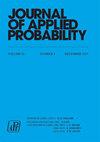论谣言在怀疑论者中存活的可能性
IF 0.7
4区 数学
Q3 STATISTICS & PROBABILITY
引用次数: 2
摘要
摘要研究了非负整数线上的怀疑谣言模型。该模型首先在0和1处设置两个传播者,在所有其他自然数处设置持怀疑态度的无知者。然后,每个怀疑论者在从至少两个不同的来源收到谣言后,将谣言独立地传播给其右侧随机距离内的个人。我们说,如果以这种方式听到谣言的顶点集的大小是无限的,则该过程存活。我们精确地计算了生存概率,并得到了怀疑论者最终谣言范围尾部分布的一些边界。我们还证明,在同样的条件下,谣言在不怀疑论者和怀疑论者中间消失。本文章由计算机程序翻译,如有差异,请以英文原文为准。
On the probability of rumour survival among sceptics
Abstract We study a sceptical rumour model on the non-negative integer line. The model starts with two spreaders at sites 0, 1 and sceptical ignorants at all other natural numbers. Then each sceptic transmits the rumour, independently, to the individuals within a random distance on its right after s/he receives the rumour from at least two different sources. We say that the process survives if the size of the set of vertices which heard the rumour in this fashion is infinite. We calculate the probability of survival exactly, and obtain some bounds for the tail distribution of the final range of the rumour among sceptics. We also prove that the rumour dies out among non-sceptics and sceptics, under the same condition.
求助全文
通过发布文献求助,成功后即可免费获取论文全文。
去求助
来源期刊

Journal of Applied Probability
数学-统计学与概率论
CiteScore
1.50
自引率
10.00%
发文量
92
审稿时长
6-12 weeks
期刊介绍:
Journal of Applied Probability is the oldest journal devoted to the publication of research in the field of applied probability. It is an international journal published by the Applied Probability Trust, and it serves as a companion publication to the Advances in Applied Probability. Its wide audience includes leading researchers across the entire spectrum of applied probability, including biosciences applications, operations research, telecommunications, computer science, engineering, epidemiology, financial mathematics, the physical and social sciences, and any field where stochastic modeling is used.
A submission to Applied Probability represents a submission that may, at the Editor-in-Chief’s discretion, appear in either the Journal of Applied Probability or the Advances in Applied Probability. Typically, shorter papers appear in the Journal, with longer contributions appearing in the Advances.
 求助内容:
求助内容: 应助结果提醒方式:
应助结果提醒方式:


